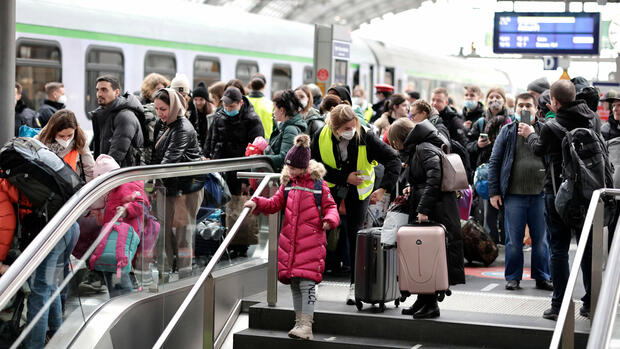Refugee migration only has a limited impact on the needs of the labor market.
(Photo: IMAGO/Jens Schicke)
Berlin Germany is currently experiencing record levels of immigration, but this only partly contributes to the goal of securing skilled workers. Many immigrants are refugees, while migration from EU countries is declining and the recruitment of skilled workers from third countries is only making slow progress.
The employer-related German Economic Institute (IW) points this out in a new study that is available to Handelsblatt. Germany is “faced with the great challenge that from an economic point of view it should promote some forms of immigration very specifically and at the same time act more restrictively elsewhere, although ethical and humanitarian aspects must always be kept in mind,” writes IW economist Wido Geis-Thöne .
Last year, 1.46 million more people immigrated to Germany than emigrated – a record. The previous high from 2015 was exceeded by more than a quarter. The strong increase is primarily due to refugees from Ukraine who do not have to go through the asylum procedure, of which 960,000 came.
But refugee migration from other parts of the world is also increasing again. In 2022, 218,000 initial applications for asylum were made in Germany, and in the first half of 2023 there were already 150,000.
However, refugees are often only available to the labor market with a delay or not at all because they first have to learn the language, acquire qualifications or – as is the case with many Ukrainian women – look after small children. In February, just under one in three Syrians of working age living in Germany had a job subject to social security contributions – a good half of them at skilled worker level.
People from western Balkan countries and eastern EU countries work particularly often
Refugee migration has also contributed to the fact that the number of employable recipients of Hartz IV or basic income without a German passport has risen from one million to 1.8 million since 2010, while the number of domestic recipients has risen from almost four to 2.1 million decreased.
>> Read here: Number of asylum seekers increased significantly in the first half of the year
The countries that became members of the European Union from 2004 and the Western Balkan countries, which have their own labor migration procedure, continue to make major contributions to securing jobs and skilled workers.
In March, 1.7 million immigrants from one of the new EU member states had a job subject to social security contributions – a good six times as many as in 2020. The largest group of immigrants from this region last year was the Romanians.
Without immigrants from the new EU member states, who settled not only in big cities but also in rural areas, “Germany’s economic development would in all probability have been much less positive,” writes Geis-Thöne.
However, he also points out that many Eastern and Southeastern European countries are now struggling with similar demographic problems as Germany, which speaks against prioritizing the recruitment of skilled workers from this region.
Read more about immigration
Things are completely different in India with its many young and often well-educated residents. As the country of origin for highly qualified people from outside the EU, the country with the largest population in the world, alongside Turkey, already plays the central role today.
Almost 57 percent of the Indians in Germany who are subject to social security contributions work in a job that requires a university or further training qualification as a master craftsman, technician or business administrator. The rate for foreigners as a whole is only around 17 percent and for residents with a German passport it is 30 percent. However, the number of Indians in jobs subject to social security contributions was “rather manageable” at 106,000 in September 2022, according to the study.
>> Read here: FDP wants to declare more countries to be safe countries of origin
In the foreseeable future, the permeability of the EU’s external borders will primarily determine how many refugees come to Germany. The new EU asylum compromise sealed in the spring will probably do little to change this.
The author concludes that it is all the more important to highlight the positive aspects of immigration in public without concealing the negative ones. “Otherwise there is a risk that positions critical of immigration will spread and the openness of society will decrease.”
More: The immigration illusion – why more immigration won’t save us from the labor shortage

